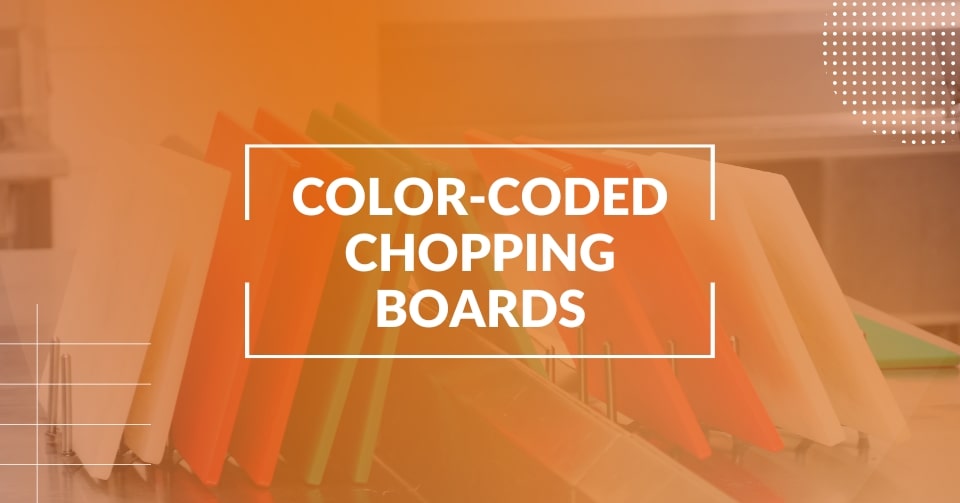Walk into any professional kitchen, and you’ll see a flurry of activity, chefs chopping, prepping, plating. But behind the scenes of this culinary dance is a quiet hero that keeps the entire operation safe: the humble color-coded chopping board.
As a food safety professional, I’ve seen how something as small as using the wrong board for raw chicken or sliced tomatoes can lead to serious cross-contamination. It’s not just a hygiene issue, it’s a public health risk. Color-coded chopping boards are one of the simplest and most effective tools we have to reduce that risk. They provide a clear, visual system that helps kitchen staff separate raw meat from ready-to-eat foods, allergens from staples, and seafood from vegetables, all in a glance.
In this blog, I’ll break down why this system matters more than ever, how to implement it properly, and how food safety software can make it part of a stronger food safety culture in your kitchen. Whether you’re running a cloud kitchen, a restaurant, or a big food manufacturing facility, this color code isn’t just good practice, it’s a frontline defense for food safety.
Let’s get chopping, safely.
What Are Color-Coded Chopping Boards?
Color-coded chopping boards are exactly what they sound like, cutting boards in different colors, each designated for a specific type of food. This isn’t just for sake of it or kitchen organization; it’s a critical part of maintaining hygiene and preventing foodborne illness.
Each color is assigned to a food group – red for raw meat, blue for raw fish, green for vegetables, and so on.
The goal is simple: avoid cross-contamination. When raw chicken shares a board with salad greens, you’re inviting harmful pathogens like Salmonella or E. coli into food that may not go through another cooking step. That’s a food safety nightmare waiting to happen.
In my work with food businesses from small cafés to large-scale processors, I’ve found that color-coding is one of the easiest systems to train, scale, and sustain. It’s a visual safety net that reinforces proper food handling, even in fast-paced environments where staff are juggling multiple prep tasks.
Think of it like traffic signals for your kitchen. Everyone knows what red and green mean on the road, and with the right training, your team will know what they mean on the prep table, too. Though direct percentages are rare, expert sources (like Sylvia A Consultancy and The UK Food Standards Agency) consistently highlight color-coding as a simple, efficient method to reduce cross-contamination and assign kitchen staff quickly to safe practice.
Why Color Coding Matters in Food Safety?
Color coding in food safety is more than a visual preference. It’s rather a strategic defense against invisible threats.
By assigning specific colors to different food categories, kitchens can manage food handling, minimize confusion, and avoid accidental contact between raw and ready-to-eat items. This approach enhances operational clarity, especially during busy service hours, while supporting allergen segregation and regulatory compliance.
As food allergies and audit standards become stricter, a clearly color-coded system offers not just control, but confidence, helping teams work faster, cleaner, and with purpose.
Who Needs to Follow This?
You might be wondering do color-coded chopping boards really apply to every kitchen? The short answer: yes. Whether you’re running a full-scale manufacturing facility or prepping meals in a small café, the principles of food safety don’t change. Cross-contamination doesn’t care how big or small your operation is, it only takes one slip to cause a serious health risk.
For Food Manufacturers and Processors
In high-volume food production, consistency is everything. A color-coded system is essential for ensuring raw materials, allergens, and ready-to-eat items are all handled separately. It supports your HACCP plans, simplifies audits, and keeps your food safety certifications intact.
For Restaurants and Cloud Kitchens
Kitchens that handle a variety of proteins, vegetables, and specialty items, especially under time pressure, are particularly vulnerable to mistakes. Color-coded boards help line cooks quickly identify the right equipment and prevent allergen and raw food mishandling.
For Institutions Like Schools and Hospitals
Places like schools with young children and populations with low immune systems in hospitals are at higher risks. These places require strict hygiene standards. Color-coded chopping codes add an extra layer of protection through visuals.
Even Home Kitchens Can Benefit
Food poisoning doesn’t only happen in commercial kitchens. Home cooks, especially those handling raw meat and fresh produce together, can benefit from adopting this simple practice. With so many affordable sets available, it’s an easy upgrade for better hygiene.
Common Mistakes to Avoid
While color-coded chopping boards are a powerful tool for food safety, they’re only effective when used correctly. Over the years, I’ve seen even the most well-intentioned kitchens make small mistakes that can completely undermine the system. Here are the most common ones to watch out for and how to fix them.
1. Mixing Up the Colors
This one’s obvious, but it happens more often than you’d think. A red board being used for vegetables or a green board for raw chicken is a recipe for cross-contamination. The solution? Post a clear color reference chart in the prep area and reinforce it through regular staff training.
2. Not Replacing Worn or Damaged Boards
Once a board has deep grooves or discoloration, it’s harder to clean and can harbor bacteria even after washing. Old boards lose their non-porous surface, which is critical for hygiene. Inspect boards regularly and replace them as soon as they show signs of wear.
3. Inconsistent Cleaning Procedures
Color-coding is no substitute for proper cleaning. Boards need to be thoroughly washed and sanitized between uses, even when used for the same food category. Don’t assume a green board used earlier for lettuce is safe to reuse for herbs without cleaning.
4. Ignoring Allergen Protocols
Many kitchens forget to integrate allergen control into their board system. Using a shared board even a clean one without clear allergen-free designation (like purple) can expose sensitive diners to hidden dangers.
5. Assuming Everyone Knows the Code
Just because your team has color-coded boards doesn’t mean they know how to use them. New hires, seasonal staff, or temporary workers may not be familiar with the system. Incorporate this training into onboarding and include quick visual cues in every prep area.
How to Implement a Color-Coded System?
Installing a color-coded chopping board system in your kitchen isn’t just about buying a set of boards it’s about building a routine of food safety. Whether you’re starting from scratch or refining your existing process, here’s how to implement the system:
1. Choose a Standard Color Scheme
Standard Chopping Board Color Guide:
- Red – Raw meat
- Blue – Raw fish and seafood
- Green – Fruits and vegetables
- Yellow – Cooked meats
- Brown – Root vegetables
- White – Dairy and bakery items
- Purple – Allergen-free (gluten-free, nut-free, etc.)
Consistency across your entire team and facility is key, don’t mix and match systems.
2. Post Visible Reference Charts
Place clear, laminated posters in all prep areas showing which color corresponds to which food group. Visual reminders reinforce habits, especially during rush hours.
3. Train All Staff (And Retrain Regularly)
Every team member, from prep cooks to dishwashers, should understand the color code. Make it part of onboarding, refresh it during regular safety meetings, and run occasional spot checks or quizzes.
4. Create Cleaning and Replacement Protocols
Boards should be cleaned and sanitized immediately after use, and deep grooves or staining should be grounds for replacement. Set up a weekly inspection routine and log board conditions as part of your FSMS or HACCP documentation.
5. Label and Store Separately
Store each board in a labeled rack or slot to prevent mix-ups. Color-coding loses its power if boards get stacked randomly or shared across prep stations.
6. Integrate the System into Your FSMS
Document your chopping board protocol as part of your Food Safety Management System. This creates accountability, satisfies auditor expectations, and ensures your procedures are easy to train and track.
Relevance of Chart Data
| Key Insight | Source Type | Explanation |
|---|---|---|
| Up to 3.6% pathogen transfer | Scientific study (Japan, Food Control journal) | This figure comes from a controlled experiment that measured E. coli transfer from cutting boards to different types of vegetables during meal prep. |
| Frequent cross-use of boards | Observational studies in home kitchens | Multiple food safety studies, including those cited by the USDA and academic researchers, report that cross-contamination often occurs because people reuse cutting boards without cleaning. |
| Consensus among food safety pros | Industry guidance (e.g., UK FSA, BRCGS, HACCP trainers) | Experts routinely recommend color coding as a best practice in kitchens, and food safety audits often look for these systems in place. |
Tools That Help: How FoodReady Supports Chopping Board Hygiene
Implementing a color-coded chopping board system is one thing—sustaining it is another. That’s where FoodReady comes in. As someone who’s helped food businesses set up and maintain food safety protocols, I’ve seen how digital tools can transform everyday practices like chopping board hygiene into consistent, auditable, and stress-free routines.
1. Digital SOPs for Chopping Board Use
FoodReady AI food safety software allows you to create and manage Standard Operating Procedures (SOPs) specifically for your chopping board system. Our software has live SOPs in the cloud so its accessible anytime for everyone. Its assists assigning colors to food types, outlining cleaning steps, or listing storage requirements, every detail can be captured and shared across your team.
2. Custom Cleaning Schedules and Checklists
Boards need regular sanitizing to stay effective, and FoodReady helps you set custom cleaning schedules with automated reminders and task checklists. Your team gets notified, and you get a digital log perfect for internal reviews or third-party audits.
3. Visual Training and Onboarding Tools
Using FoodReady, you can upload images or video walkthroughs of proper chopping board use. This supports visual learners and ensures your training is aligned across shifts and locations. You can even assign specific learning modules to new staff, so no one slips through the cracks.
4. Allergen Control Integration
FoodReady’s allergen management tools allow you to flag equipment like purple boards for designated allergen-free tasks. These are then linked into your production workflows, giving your kitchen team a clear path to compliance when prepping gluten-free or allergy-sensitive meals.
5. Internal Audits and Documentation
Need to show your health inspector how you manage board hygiene? Our software makes it easy to run internal audits, upload inspection photos, and generate digital records. You’ll have proof that your chopping board system isn’t just policy, it’s a practice.
Conclusion: Small Boards, Big Impact.
In food safety, it’s often the smallest habits that create the biggest protections. Color-coded chopping boards may seem like a simple tool, but their impact reaches every corner of your kitchen, from preventing cross-contamination to supporting allergen management and staff accountability.
As a food safety expert, I always say: systems don’t need to be complex instead it needs to be powerful. When properly implemented, a color-coded board system becomes second nature to your team and a quiet hero in your HACCP plan. It’s one of those rare practices that’s cost-effective, easy to train, and incredibly effective in reducing food safety risks.
But like any system, it only works when it’s part of a bigger food safety culture—one built on clarity, consistency, and care. With tools like FoodReady, you can move beyond just buying the right boards and start building a kitchen where food safety lives in every decision, every task, every shift.
Small boards. Big protection. Lasting peace of mind.
FAQ
Not always but they are strongly recommended by most food safety authorities and are often expected in HACCP-based systems. In many audits, the absence of a color-coded system can raise red flags about cross-contamination controls.
Even in small kitchens, using separate boards for raw meat, vegetables, and ready-to-eat foods drastically reduces foodborne illness risks. Compact kitchens can use smaller board sets or label edges clearly to stay compliant and safe.
Stickers and labels tend to fade, peel, or fall off especially after multiple washes. Solid-colored boards offer a more durable, visible, and foolproof solution, especially in high-turnover kitchens.
Replace chopping boards as soon as they show deep grooves, warping, discoloration, or become difficult to sanitize. As a rule of thumb, inspect weekly and plan for rotation every 6–12 months depending on use.
If your kitchen caters to allergen-sensitive customers (gluten-free, nut-free, etc.), a dedicated purple board adds a layer of protection and professionalism. It’s not mandatory in every country, but it’s considered best practice and shows you take allergen control seriously.
Even the best chopping board system fails without proper training. Everyone on your team from head chefs to part-time prep workers should know what each color means and how to clean and store boards properly.








